Chasing down an elusive key-off drain problem can test the patience of any technician. Here are some tips and hints to make your life a little easier.
Most drivers consider a reliable car a necessity. We must be on time for work, to pick kids up from school, and to a myriad of other destinations. There is very little flexibility in modern life, so a car that does not start reliably is unacceptable for most people.
A battery that goes dead as a car sits can be very frustrating for both drivers and technicians. A shop may only have one chance to diagnose and repair a key-off drain before a customer looks elsewhere, just as a customer may have only one opportunity to meet their obligations using a reliable car. This is why a full effort should be made whenever investigating a key-off drain.
Excessive key-off drains will cause the familiar symptoms of a discharged battery, such as dim lights or no lights, slow cranking or no cranking, etc. However, symptoms of a discharged battery aren’t always caused by a key-off drain, so the first step is always to answer these questions: Is a discharged battery the cause of the complaint, and if so, what was the cause of the discharged battery?
A full recharge and evaluation of the battery should be the very first step. If the battery voltage is low, test results may not be valid. Control units do not like to operate on low voltage, so if they don’t have an adequate voltage supply, they may not be “thinking†straight. Without good power, control units should not be held responsible for their actions, including sucking juice when they should be asleep. Also, lower supply voltage will push fewer amps through a given load, so the level of key-off drain may look artificially low if the battery isn’t fully charged during testing.
A few more possibilities should be eliminated before checking key-off drain. First, a problem with charging system can certainly cause a discharged battery, so it should be tested. Also, a history should be obtained from the customer. All cars use some current while “offâ€. Control units, clocks, anti-theft, keyless entry, and other systems need to draw power, so some key-off drain is completely normal. Any car that sits unused for long enough will eventually run the battery down. If a car comes in with a layer of dust, spider webs, and mouse droppings, the problem may lie with how the car is being used, not with key-off drain.
So, if key-off power draw is normal, how much is too much? The answer, like so many things in life, is not black and white. Different models have different levels of normal draw. The normal key-off drain in a 1996 Maxima is different than in a 2011 Versa. The only way to know what’s normal for a particular year, model, and trim is to compare it against another identical known good car. In general, older models will draw more than newer models, and fancier models will draw more than simpler models.
Shop teacher A says key-off drain should never exceed 150mA. Shop teacher B says key-off drain should never exceed 60mA. Who’s right? Could be A, could be B, could be both, could be neither. It all depends on the car, the battery, and the driving habits of the owner. Experience and comparison against identical known good cars are your best “specificationsâ€.
You might think that looking at the reserve capacity (RC) of the installed battery, and then comparing it to the key-off drain, could be used to calculate how long the battery is likely to maintain a charge capable of starting the engine. For instance, if a the installed battery has a 100 amp/hour rating, and the key-off drain is 100 mA, we might estimate that the battery should maintain a charge for 1000 hours or 41 days.
There are however, a number of variables that will pummel the accuracy of this crude equation. First, the amp hour rating is based on discharging the battery to 10.5V. Is a 10.5V battery likely to start a car? Then there are other questions. Has the installed battery maintained its original AH rating? When the car is parked, is the battery typically 100% charged? Then there’s Peukert’s Law, which states that changes in the discharge rate will affect the reserve capacity of a battery.
Key off-drain is usually not constant. Control units wake up and go to sleep as needed and self tests can run automatically on a schedule. There will be periods where current draw is too high for good battery life, but periods of high draw are part of normal key-off operation as long as they are not sustained for too long. Often, current draw will be higher after input, such as operating any system on the car or reconnecting the battery. It’s best to test for key-off drain after the car has been sitting for quite some time.
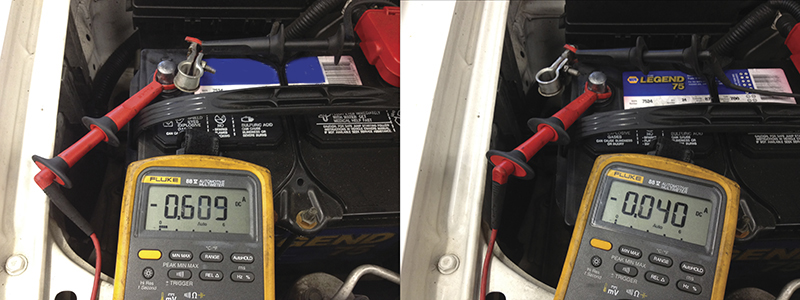
How much is too much? 609mA is certainly too much for continuous draw on any car. 40mA is very unlikely to cause problems, and is normal for this older fully loaded QX4.
How to Test for Key-Off Drain
- Clean the battery terminals of corrosion, grease, or sealer.
- Charge and test the battery using the GR8 battery diagnostic station.
- Remove the keys from the car and close and lock all doors.
- Connect one lead of the ammeter to a good ground point or the negative battery cable.
- Loosen the negative terminal clamp and slide it up while continuing to maintain contact with the post. Once the clamp is high enough, slide the other ammeter lead clip onto the post.
- Remove the negative cable clamp from the terminal and note the reading on the ammeter.
- If the reading is too high, wait 20 min and check again.
Keeping the negative cable connected until the ammeter completes the circuit is not mandatory. You could simply disconnect the negative cable, and then connect the ammeter between the negative post and the negative cable. However, if the circuit is broken, there is usually a period of increased current draw as control units wake up after the power outage, so you may have to wait longer for the current flow to die down to its normal key-off level. Also, all of the customer’s presets will be lost and window, door, and sunroof initializations will need to be performed. Memory savers cannot be used while conducting key-off drain testing because they provide an alternate unmeasured power source and will skew test results.
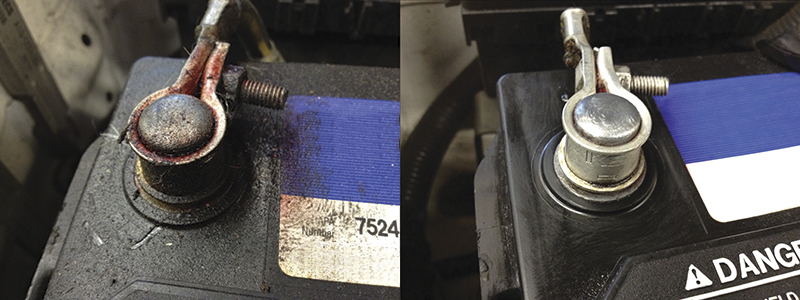
Solid test lead connections are essential to accurate diagnosis. A few moments spent on good work habits like removing sealer, grease, or corrosion from the battery terminals will save time in the long run.
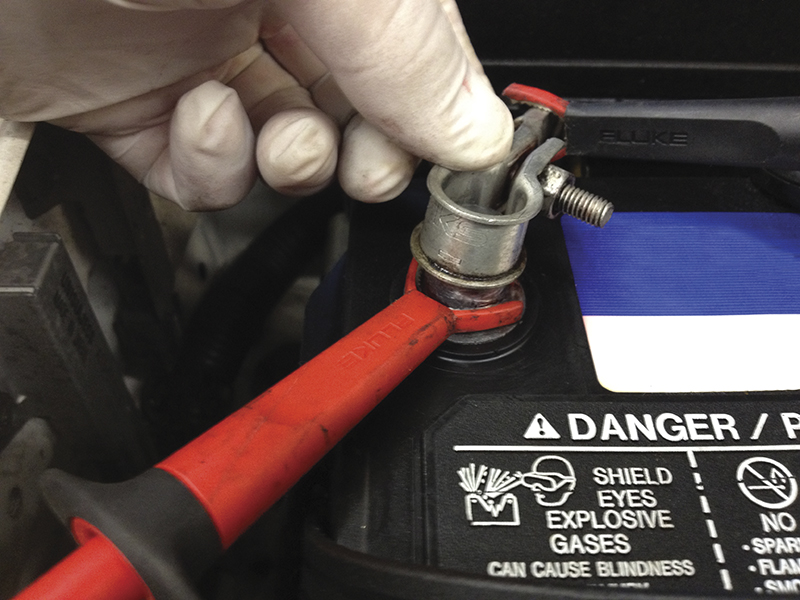
An ammeter must be connected in series to measure current draw. If careful, it’s possible to connect the ammeter without breaking the circuit to avoid the temporary increase in current that often accompanies electrical systems “waking up.â€
If excessive current draw is found, the next step is to find the source of the draw. The simplest way to start is by pulling fuses one at a time. Often (but not always) circuits that are provided key off power are fused in the under-hood fuse box, so that is a good place to start. Pull one fuse at a time while checking for a drop in the current flow. It’s best to follow a pattern so no fuses are missed. If the current doesn’t drop substantially with any of the fuses in the under-hood fuse box, move on to the other fuse boxes and repeat the process, pulling one fuse at a time.
Once the circuit responsible for the bulk of the draw is found, take a look at the Power Supply, Ground, and Circuit Elements section of the service manual. There you’ll find a list of circuits powered by each fuse. Once you know the circuits powered by the fuse, check the individual wiring diagrams to find out which components and connectors are involved. Once this is known, look up the locations and make a plan of attack based on effective isolation of circuit elements and accessibility of connectors.

Pull fuses one at a time and take note of the decrease in current consumption (if any). This will allow you to map out the total key-off draw.
For instance, if you found circuit that powered four components is pulling 300mA, you might look for a connector that would depower two of the four branches. Or, depending on location it might be easiest to just disconnect the components one at a time. Time spent learning about the circuit, connectors, and locations will make diagnosis a lot quicker. A plan of attack is invaluable.
Logic is a diagnostician’s best tool. That said, it sometimes pays to start with an educated guess. Who knows, you may get lucky with it. There are a few “repeat offenders†when it comes to key-off drains. Before proceeding in purely a logical fashion, it might be a good idea to start by questioning some of the usual suspects.
Audio units always have at least one key-off power source, and they do fail with some regularity. If the CD player decides it needs to eject a stuck CD, it may not give up on its quest until the battery is dead.

Finding the fuse responsible for the draw is only part of the challenge. The next step is to determine what systems are powered by the fuse.

Don’t miss the forest for the trees! Take a moment to step back and stop, look, and listen before getting too fancy with diagnosis.
Door switches are another common failure. Taking a moment or two to really look at the car can pay off. Just look for any lights that are on inside the car with all of the doors closed. A dome light that’s on all the time will certainly drain the battery.
Trunk lights can be a little trickier since the trunk is not visible from the outside of the car. The switch is typically located on the latch or striker, and they usually are obviously broken or loose when they fail, so it’s worthwhile to take a quick look. If in doubt, most Nissan products have a trunk that will comfortably hold a human.
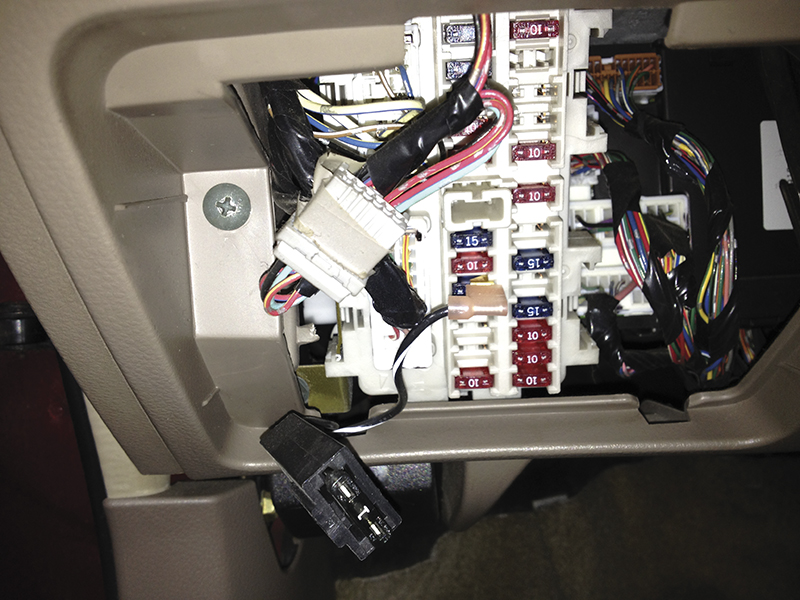
Guilty until proven innocent! Aftermarket junk causes a lot of key-off drain complaints. Start by assuming the worst and pull its cord.
Finally, the glove box light is another place to look. Thanks to GPS, most folks have stopped overstuffing the glovebox with maps, but unfortunately, many have found other stuff to cram into the glovebox to hold the door slightly ajar and keep the light on all night.
Add-on Headaches
Folks love to add stuff to their cars. Nissan knows this and provides quite a few add-on accessories for a variety of needs or wants. Unfortunately for those of us who fix cars, the vast majority of add-on accessories are not Genuine Nissan kits.
Some aftermarket accessory kits are well designed, but so many are not. Poorly designed or installed kits can create some real headaches; often the hardest problems to diagnose are problems that were created by someone else modifying the car. Keep an eye out for anything that is not OE. When in doubt, temporarily disable aftermarket devices to determine if they are the source of the trouble before going too deep with standard diagnosis.
Tough Cases
An intermittent problem with the battery could cause what might at first appear to be key-off drain. An intermittent cell short can bring the static voltage down to 10.5V, which might appear to be a discharged battery. It’s possible for a shorted cell to come and go as components or sediment shift inside the battery and this can be very frustrating. The battery may test good after charging, but then drop a cell once your customer drives the car home. If the battery is not sealed, check under the caps for debris floating in the electrolyte. If debris is found, suspect a battery problem.
Very intermittent drains are another tough-to-diagnose problem. A loose detent in the headlight switch might cause the high beams to come on in the middle of the night. A loose or misadjusted striker for the trunk latch might cause the trunk light to stay on sometimes, but of course not while you’re testing. A damaged door switch might work nine times out of ten, but you won’t know that unless you work the doors enough while testing to induce a failure. Best advice? First, don’t ignore seemingly unrelated problems you encounter. If the headlight stalk feels floppy, consider if there is any way it might be related to the customer complaint. Second, operate the car like the customer would. If there is no drain found with the car sitting static, start trying to simulate normal use of the car.
Measuring current draw overnight is sometimes necessary. Using an ammeter in MIN/MAX recording mode can be very helpful. Remember that various tests may be run with the key off, so a 2A draw in the middle of the night may not be a problem. Use the average function to differentiate between normal spikes in current draw and excessive draw.
Involving the Customer
Talking to customers serves two purposes. First, it may lead to some insight about how to induce the drain. Ask customer questions about their driving routines and let them know that you are trying to duplicate the things they do with the car to get it to act up. Second, involving customers gives them a window into the challenges you are facing, and may spur some empathy and feelings of good will, rather than just the frustration of owning a broken car.

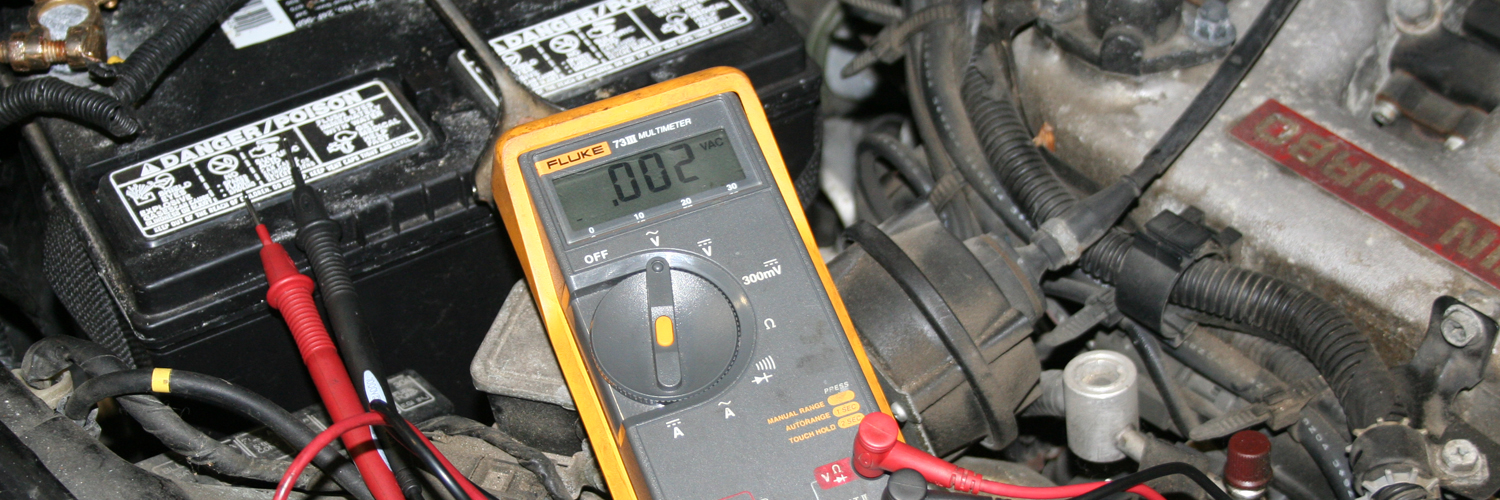
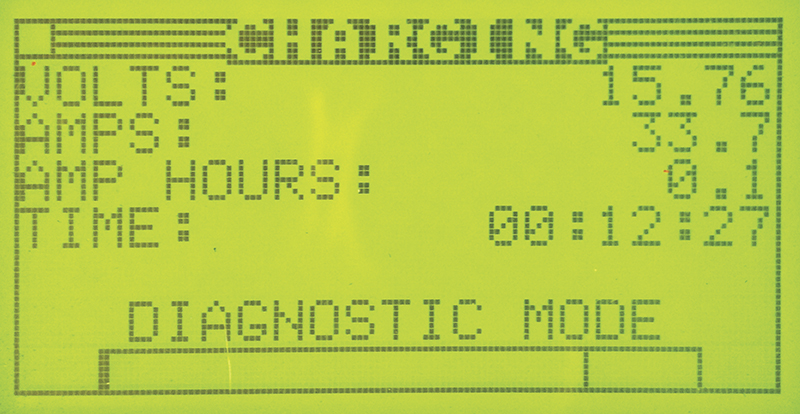
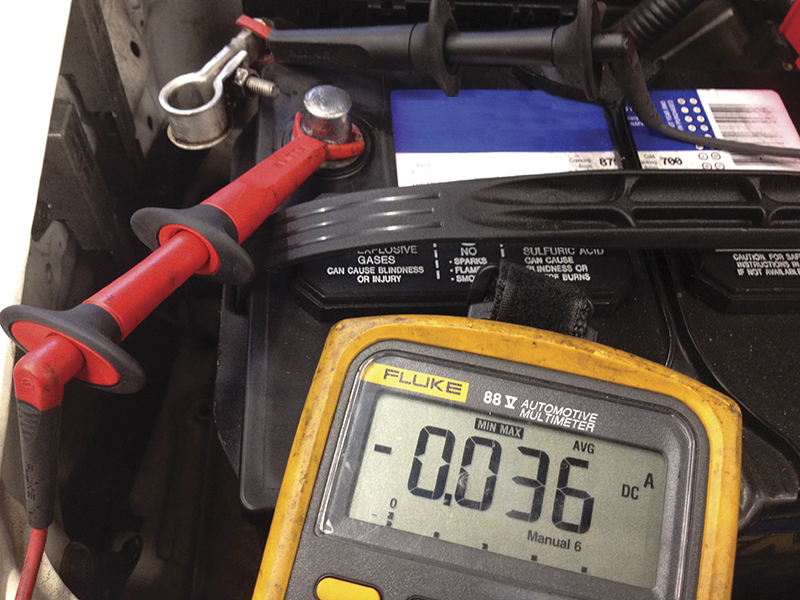




0 Comments